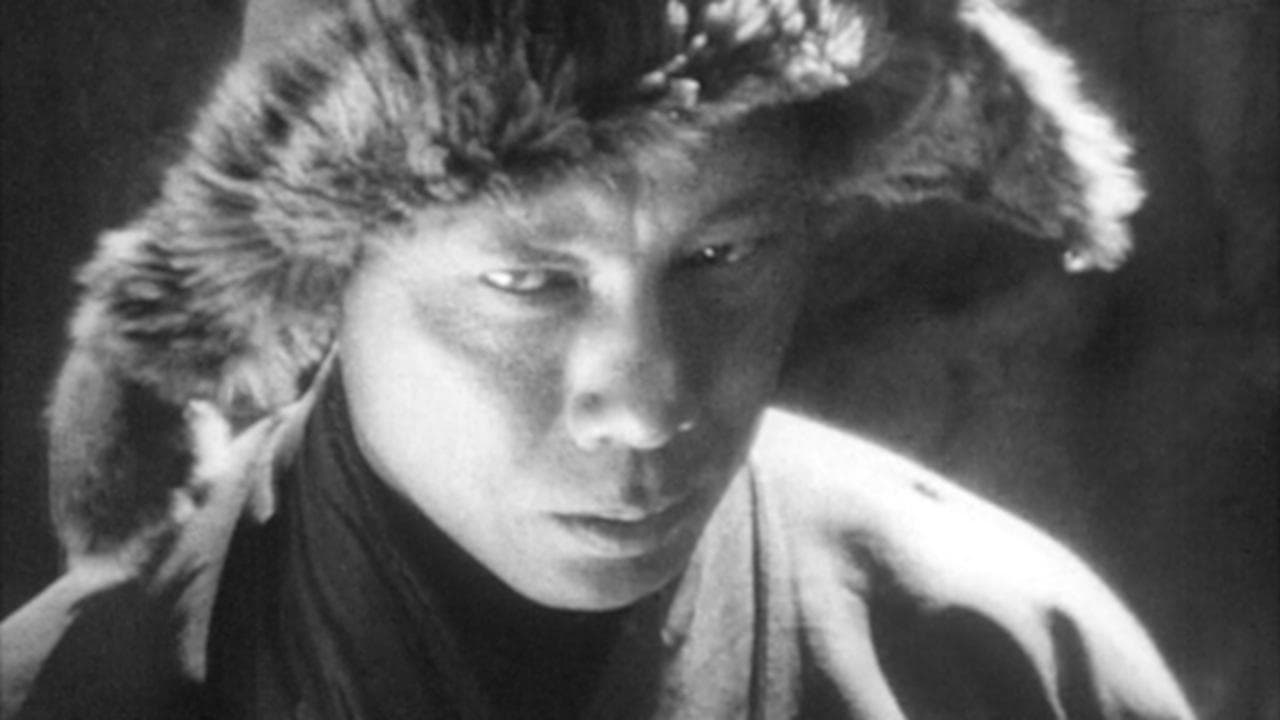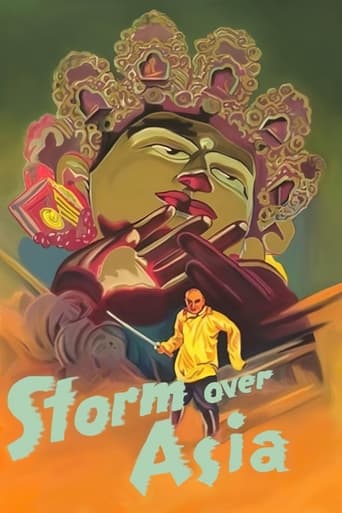

"Storm Over Asia" is a well made film. As other reviewers have pointed out, the film expertly uses film editing to make a very modern style film for 1928. It is really artistic and worth seeing--though there are also some serious lulls in the film that could have been tightened up a bit. However, that being said, the film is very obvious propaganda by the new Soviet government--and it sure isn't subtle about it.A Mongol goes to town to sell a very valuable silver fox skin to the evil capitalists. Naturally, being evil (and fat) capitalists, they cheat the simple Mongolian man BUT they have a surprise--he won't just stand there and accept this maltreatment. He attacks the bad white men and flees to the hills--and eventually becomes a member of the communist partisans in the Russian Revolution. At this point, the film seems to drop this plot and A LOT of footage of Mongolian Buddhists is shown--including their costumes, dances and the like. At first, it seems like a nice bit of footage about these people but eventually you realize that the film is meant to mock Buddhist beliefs about the reincarnated Lama. Then, the communist forces attack--trying to kill off the evil forces of counter-revolution and international capitalism. Well what about our Mongolian hero? Where does he come into all this? See the film and find out for yourself--and you'll probably be quite surprised where the film goes next.From an artistic point of view, the film is pretty good. The ending is also quite rousing. But as propaganda, it's very heavy-handed and not nearly as convincing or realistic as the much more famous film, "Potemkin" (also called "Battleship Potemkin"). I do understand that the new Soviet government was attempting to legitimize itself and drum up support by this film, but it just seemed to take the wrong approach as it lacked subtlety. As another reviewer pointed out, the villains in this film are just caricatures.By the way, IMDb lists the film at 82 minutes. The DVD I watched clocks in at 125 minutes!! Is IMDb wrong or are there multiple versions and I just saw a longer one?
... View MoreLet me say this first: if you're willing to overlook the political message of the film and, instead, concentrate solely on its artistic qualities, you'll be more than satisfied. It has some of the most magnificent montage editing I've ever seen--quick and frenetic--and shows off the vast, open landscape quite well. There are a couple particularly memorable examples. At one point, a mountain rebel is on his deathbed; the film cuts between him dying and a sun low on the horizon, to touching effect. Later, a soldier executes an unarmed prisoner and feels some remorse as a shot of dirty, viscous mud is inserted, suggestive of the "muddy" morality here. And (spoiler) no audience could ever forget the climactic end of the film, with the protagonist going berserk and leading a small army against the government troops: wind blowing, knocking trees and soldiers over, while the rebels charge headlong. There are two storms in this last scene. A meteorological one, and a figurative, violent one. In short, Intelligent film-making with splendid cinematography and Soviet editing. (Even some canted frames, which I'd call innovative for such an early film.) Sure, the propaganda is conspicuous, but who cares? The techniques, the shots, are absolutely beautiful.
... View MoreIn his last silent film, Storm Over Asia, Pudovkin changed direction by creating a non-Russian plot. Although the film deals with political situations, it is not about a Soviet worker, farmer or mother-- but about a Mongolian, and for this Pudovkin received a lot of condemnation by the film critics of his time.The chronicle is set in 1918 (at the time of the Civil War) on the Mongolian steppe. The narrative is focused on one character; the brave Mongol hunter Bair. He comes into a precarious situation when his father falls ill, and Bair must go to the town to trade his pelts for food for the family. After a disagreement with a wealthy British trader over the price of his treasured silver fox fur, the hunter is forced to flee into the mountains where he meets up with a group of Red Partisans. After a visually confusing fighting scene with quick shots and unidentifiable participants, the hunter is captured by the British and taken back to the city. Unable to communicate with the British officers, they order Bair to be executed.At this point the narrative splits and we follow the actions of the officers and the lengthy execution of our protagonist. The officers soon discover that Bair is a descendant of Genghis Khan (by an amulet that Bair chance acquired) and attempt to stop the execution. After the discovery of Bair's ancestry, the British take our protagonist and attempt to set his up as a prince in order to justify their own control and power. After experiencing several awkward moments and being put on display, Bair becomes enraged and destroys the British headquarters. He then flees the town. The climax, his fight, has quick editing and flashes the words "down," "bandits," "thieves" and "robbers" with an image of our protagonist screaming in rebellion. Pudovkin juxtaposes the dramatic and quickly edited scene with a subsequent attack on the Mongolian steppe. The protagonist is on horseback wielding a sword and followed by a great horde of warriors, evoking images of Genghis Khan. The dust and debris of the steppe follows this attack, forming the image of a storm sweeping over the land and attacking the British.The scenes on the steppe are very significant to the mood of the film. When all is well in the film, the steppe echoes this seemingly peaceful feeling. During the climax, the steppe becomes violent and windy, much like the horde of warriors. These natural shots set the mood for the narrative and reflect the emotions of the protagonist. Pudovkin implements fade-ins and outs. This is one of the earliest films where this cinematic technique has been implemented in a productive way, pertaining to the narrative by signaling a time lapse or location change.This film is very unique for its time. It is one of the first Russian films with non-Russian characters (all of the Mongolian cast are real Mongolians). It also focuses on political themes that do not glorify Soviets. Many critics at the time of release saw this film as non-Soviet and non-political because it neither deals with Russia nor serves a direct purpose for a propaganda film. Pudovkin's critics were ruthless and alleged that moving away from Soviet themes was going to lead a film crisis. Where films would no longer confront and convey the complex problems of Soviet society. Many also alleged that Pudovkin's endeavor was unattainable and uninteresting for audiences, who just could not grasp the meaning behind the film. There was no purpose for Storm over Asia to serve in the propaganda films of the time. This detachment from the Soviet themes was refreshing for me, so I would infer that it would also be for Russians at the time.
... View MoreContrary to what the English guy says (hey, the Brits are the bad guys in this movie, whaddaya expect), this is to my mind the most impressive work of Soviet silent cinema-- an epic with several dazzling sequences of rat-a-tat-tat editing that invite comparison with Gance's Napoleon, as well as a deliberate build to an explosive climax that, in its willingness to delay gratification until almost the breaking point, has the operatic grandeur of something like The Godfather. Highly recommended (in fact, highly recommended before you see less accessible works such as October or Potemkin).
... View More